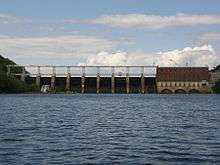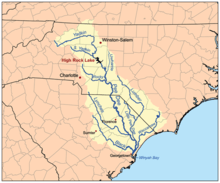High Rock Lake
| High Rock Lake | |
|---|---|
 Abbotts Creek section (Spring 2007) | |
| Location | Davidson / Rowan counties, North Carolina, United States |
| Coordinates | 35°37′44″N 80°15′4″W / 35.62889°N 80.25111°WCoordinates: 35°37′44″N 80°15′4″W / 35.62889°N 80.25111°W |
| Type | Reservoir |
| Primary inflows | Yadkin River, Abbotts Creek South Yadkin River |
| Primary outflows | Tuckertown Reservoir |
| Basin countries | United States |
| Surface area | 15,180 acres (61.4 km2) |
| Surface elevation | 655 ft (200 m) at full pool[1] |
| Settlements | Southmont, Lexington, Salisbury |
| References | [1] |
High Rock Lake is a reservoir lake located in the Davidson and Rowan counties of North Carolina, serving as a boundary between them. It is a reservoir for hydroelectric power generation. It is the northernmost of the Uwharrie Lakes and the second largest lake in North Carolina behind Lake Norman. Its water surface covers 15,180 acres (61 km2) and there are 365 miles (587 km) of shoreline. It begins at the confluence of the Yadkin River and the South Yadkin River. The lake's name is derived from neighboring "High Rock Mountain", the tallest mountain in the Uwharrie Mountains.[2] High Rock Lake was managed and operated by the Alcoa company. Cube Hydro Carolinas took over generating power in 2017.[3]
The lake has several bridges crossing the creeks that feed it. The NC 8 (Southmont) causeway crosses the Abbotts Creek tributary of the lake, as does a bridge at Holloway Church Road farther north of Abbotts Creek. There are numerous other bridges located in both Davidson and Rowan counties. Railroad tracks and their causeways also cross the southeastern portion of the lake at the Hwy 8 causeway and over Flat Swamp Creek. Numerous communities align the lake's banks including Lexington, Salisbury, Southmont, Linwood, High Rock, and Spencer.
Angling

High Rock Lake has been considered one of the best fishing lakes of North Carolina for a long time.[4] It has been the host of Bassmaster Tournaments, including the Bassmaster Classic in 1994, 1995, and 1998 [5] and is the site of frequent other angling competitions. The lake has ample channel, blue, and flathead catfish, plus crappie and several different sunfish such as bluegill, shellcracker and others. Striper and their hybrids as well as white bass are also abundant. The lake is best known for its quantity and quality of largemouth bass, which attract anglers from all over the United States. This is likely due to the relatively shallow nature of the lake and the tremendous amount of habitat that favor the bass.
Residential restrictions

Much of High Rock Lake is lined with privately owned homes, representing all income levels. Prior to 2008, Alcoa had required that all new homes have 8 feet (2.4 m) of water when at full pond and have 200 feet (61 m) of lake frontage before a private pier permit is issued. Boat ramps and boathouses are no longer allowed to be built, although existing structures that are maintained are grandfathered. Retaining walls at the high water mark are only allowed in extreme cases, although existing structures can be maintained. Due to the frequent fluctuations in water level, all private piers are required to be of a floating style, allowing them to be usable even with lowered water levels. The new 50 year government contract that is expected to be signed in 2008 would allow greater flexibility to add roof structures over many existing piers and modifying pier sizes, as well as a few other changes that offer somewhat more flexibility to existing lake front home owners.[6] The purpose of the restrictions are to improve water quality and habitat.
Access
There are several public ramps that can be accessed at no charge, and private ramps that can be accessed for a small fee. The lake has no restrictions on boat motor size and personal water craft are legal for use. There are no restrictions to access or use and it is available for use 24 hours a day. There are a number of campgrounds that adjoin the lake, some offering year round space rentals that also provide access to guests.
Hydroelectric power



High Rock Lake is one of four Yadkin Project dams that produce hydroelectric power for the surrounding communities. The entire Yadkin Project has a total generating capacity of nearly 215 megawatts of electricity when operating at peak capacity.[7] While hydroelectric electricity may produce less green house gas emissions than fossil fuel power plants, the Yadkin Project dams have a history of environmental impacts, with low dissolved oxygen in the tailraces of multiple dams and water quality violations for turbidity, ph and chlorophyll-a on High Rock Lake.[8] and fish consumption advisories for PCBs on Badin Lake.[9]
Drought and environmental impact
The 2001-2002 drought
Record low streamflows caused by unusually dry weather resulted in extremely low water levels at High Rock Lake during the Southeastern United States Drought of 2002.[10] These dry weather patterns began in 1998 and persisted until 2002. The final year of the drought was the worst for the lake.[11] With water levels well below full pond, fish began to die [12] due to overcrowding and a lack of water oxygen content, filling the air with rancid smells. Tourism in the area dropped and residents along the lake began to complain. When water levels plummeted to six feet above the "run of river" state (24 feet below normal), federal and state agencies closed the High Rock dam, forcing reservoirs like Badin Lake and Lake Tillery (who were at full pond status) to pick up the slack to maintain flows on the lower Yadkin/Pee Dee River. This allowed High Rock Lake to return to a level of 17 feet (5.2 m) below full pond before going down again. In the fall of 2002, the drought eased up and the Yadkin Valley experienced one of the wettest 15 months on record. By the end of 2003, water tables in the area were back to normal levels.
The 2007–2008 drought
Until Hurricane Fay passed through the area in late August 2008, most of North Carolina was experiencing drought levels that ranged from Severe to Exceptional (the highest level),[13] with rainfall averages below yearly average for the entire state, including the entire Yadkin-Pee Dee watershed. Alcoa is keeping water levels at slightly higher than historical levels for the same time of year for this reason, and possibly because their contract with the US government expired in April 2008 and is being renegotiated while Alcoa operates under a renewable one-year license. While the hurricane brought tremendous amounts of rain in a short period, filling all area lakes, it did little to replenish ground water levels, which create much of the runoff that continuously feeds streams and lakes statewide. Thirty days after receiving up to 10 inches (250 mm) of rain, most of the state still remained in mild to moderate drought status, with exceptional drought conditions (the highest level) persisting in the southwestern section of the state.
Because the 2002 drought was severe enough to not allow the launching of boats for fishing (or any other purpose), the number of fish that were killed off may have been proportional to the number that would have been caught and kept. The current number of fish in the lake appears to be close to normal. This is further demonstrated by the success of the May 2007 Bass Master's Tournament, and that there are no additional restrictions placed on the lake for fish size, excepting the longstanding restriction for crappie, which have a minimum size restriction of 8 inches (200 mm).[14] Many of the images of fish kills show the primary victim fishes as carp, which are not highly prized in the area and have since made a come back in numbers.
Drought management
During the 2007-2008 drought, Alcoa has sought and obtained permission from the U.S. Government to reduce the output from High Rock Lake from 1,400 cu ft/s (40 m3/s) to 900 cu ft/s (25 m3/s) during the fall, allowing it to maintain higher lake levels. The 2008 protocols allow Alcoa to reduce the output at the dam to be equal to the amount of water entering the lake through various creeks and the Yadkin River. While this doesn't allow the lake level to rise in dry periods, it prevents rapid decreases in the lake level and helps to maintain a steady waterflow for cities that use water from the river downstream, particularly in South Carolina which has no dams or reservoirs on the Yadkin/Pee Dee river. This has the additional environmental benefit to wildlife that depends on the lakes and river for habitat, as the river flows and lake levels fluctuate less dramatically.
Additionally, Alcoa has operated the lake using new guidelines that allow for parity in the lake levels of High Rock and Badin, farther downstream. Previously, Badin Lake had to be maintained at a level no lower than 2-foot (0.61 m) below full pond as long as High Rock could provide the water fast enough. New regulations expected to take effect in the new contract due in 2008 would make these temporary measures permanent, reducing the likelihood that High Rock would see lake levels that exceed 20 feet (6.1 m) below full pond again. As a result of the new procedures, High Rock has been kept at near-record highs during late 2007 and early 2008. This has been accomplished although the total inflow of water is less than it was during the 2002 drought, demonstrating that the previous conditions were related to both a lack of rainfall and antiquated lake management rules that were agreed to in the 1958 contract.[15]
Relicensing

The hydroelectric dam and control over the lake resources is licensed to Alcoa by FERC (U.S. Federal Energy Regulatory Commission), traditionally by the issuance of 50-year licenses to operate. This license gives the operator the ability to control all water that goes through the dam or over the spillway, within the bounds of the contract and under the guidance of FERC. Additionally, it grants a degree of control over properties that adjoin the lake, including all homes and business that border the lake. All public and private docks, public areas, and even individual home sites are subject to the rules and approval of Alcoa. This license expired in April 2008 and has been under negotiation for renewal since 2001. This means they will be operating under an annual license until the new contracts are signed and the license is issued.
As of April 2008,[16] this licensing process has stalled due to efforts by Stanly County and the City of Salisbury due to disputes about the new license, including Salisbury's demands that Alcoa pay to dredge areas near the city. This multimillion-dollar project would seek to restore this section of the lake where the city takes in water. In some areas, sedimentation has grown to over 10 feet (3.0 m) deep, and the city, the county (and many private groups and individuals) have claimed that it is due to Alcoa's management of the dam, not allowing the free flow of water during times of maximum inflow, instead only reducing the lake levels during peak demand for electricity which nets a greater profit. During the drought of 2007–2008, Alcoa has been operating under the new contract (under the supervision and with the permission of FERC), although they are not required to do so until (and if) the contract is renewed.
In June 2008, North Carolina legislators began consideration of condemning all lakes on the Yadkin River so the state could take control of hydroelectric capacity,[17] the justification being based on the fact that Alcoa now has virtually no employees in the area (unlike in the 1950s when the previous contract was signed) and no longer uses the electricity for aluminum production, instead selling the electricity for profit on the open market. Because the river and hydroelectric capacity are public assets, the question being raised is if a private company or the public (i.e.: the state) should have control over the project. Previous environmental damages caused by the management by Alcoa have also called into question the priorities of the project when it is operated solely for profit. Funding for a study to look at the issue was being considered in the 2008–2009 state budget.[18]
As of December 2010, the licensing is currently under review after the N.C. Division of Water Quality revoked their water-quality certificate that the company needs to continue operating its power-generating dams along the river.[19] The previous governor of North Carolina, Bev Perdue, and other North Carolina politicians[20] have made it a priority to recapture the Yadkin River water rights, an action that will require a vote in the United States Congress.
See also
References
- 1 2 Alcoa Power Generating Inc., Yadkin Division, High Rock Lake
- ↑ McCullough, Gary (Oct 5, 2014). "N.C. 24/27". The Charlotte Observer. Charlotte, NC. Retrieved Feb 6, 2015.
- ↑ Bergeron, Josh (2017-02-02). "Sale finalized for Yadkin River Dams". Salisbury Post. Retrieved 2017-02-02.
- ↑ North Carolina Summer Bass Fishing
- ↑ Camping in Piedmont, North Carolina
- ↑ Alcoa Power Generating Inc., Yadkin Division : Relicensing: Documents
- ↑ Alcoa Power Generating Inc., Yadkin Division : The Yadkin Project: The Value of Hydropower
- ↑ https://ncdenr.s3.amazonaws.com/s3fs/public/Water%20Quality/Planning/TMDL/Special%20Studies/High%20Rock%20Lake/HighRockBackground.ppt
- ↑ http://www.journalnow.com/news/local/officials-warn-about-eating-fish-from-badin-lake/article_4b38c04e-77fe-5215-aae4-ac65b8b7b483.html
- ↑ US Drought Monitor - June 11, 2002
- ↑ http://www.badin.org/bulletinjuly2002.htm
- ↑ http://www.savehighrocklake.org/highrock/photoindex.htm Gallery of images of High Rock Lake during the 2002 drought
- ↑ State Drought Monitor
- ↑ http://www.wildlife.state.nc.us/fs_index_03_fishing.htm Fishing Regulations for The State of North Carolina
- ↑ Winston-Salem Journal | Public Resource, Company Profits: Homeowners at High Rock raising questions about lake management
- ↑ Notice of Public Meetings on Environmental Assessment
- ↑ Yadkin River: Stanly County leaders urge state to study wresting rights to river from aluminum giant Alcoa - Independent Tribune - Concord and Kannapolis
- ↑ http://www2.journalnow.com/content/2008/jun/30/control-of-plants-at-stake/ Winston Salem Journal article on future of High Rock Lake
- ↑ http://www2.journalnow.com/news/2010/dec/10/state-should-control-yadkin-river-dams-ar-604482/
- ↑ http://charlotte.news14.com/content/top_stories/633834/nc-senator-calls-for-epa-investigation-into-alcoa
External links
- Non-profit group seeking to get the federal government to take control of High Rock Lake
- Alcoa - Current Official Conditions at High Rock Lake
- Drought Contingency Plan (updated monthly)
- High Rock Lake Association
- High-Rock.com A collection of links, images, travel and directory info for the area
- High Rock River Rats
- SaveHighRockLake.org
- Muddy Water and High Rock Lake Pirates
- A Fairly-Watered State - Lessons from the Drought-Vulnerable Yadkin Basin Region